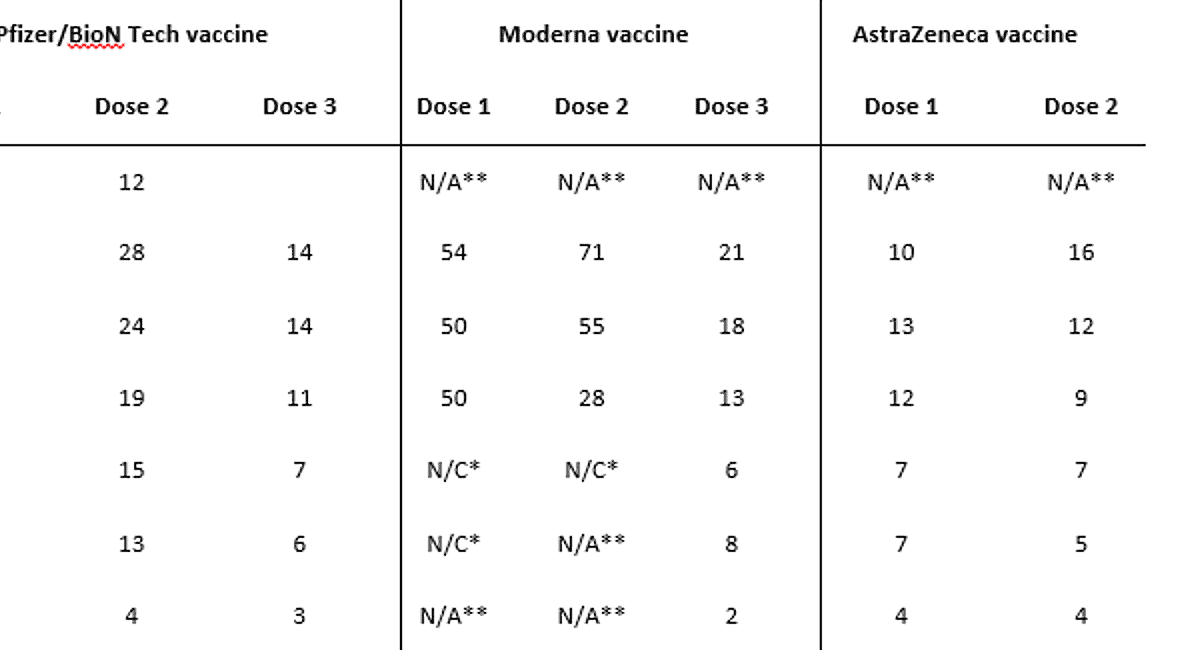By Dr Timothy Swinn
The Medicines & Healthcare products Regulation Agency (MHRA) in the UK uses the voluntary “Yellow Card” system for reporting suspected adverse vaccine effects. Whist we cannot infer causality from results of the Yellow Card scheme, it has suggested an association between COVID vaccination and myocarditis and pericarditis.
The Yellow Card weekly report update on 17th February 20221 declared reporting rates (reports per million doses) for pooled myocarditis and pericarditis of 15 for Pfizer vaccine, 26 for Moderna vaccine, and 8 for AstraZeneca vaccine. Table 1 (adapted from the Yellow Card data) shows that reporting rates were similar for 1st and 2nd doses but generally lower for booster vaccination. For the mRNA vaccines (Pfizer and Moderna), the 18-29 age group had the highest reporting rate and there were more reports for male than female patients.
To investigate this association further, Husby et al2 used nationwide registers to analyse prospectively collected data from October 2020 to October 2021 on almost 5 million individuals over the age of 12 years in Denmark. The study was a population-based cohort study, with nested self-control case series design. The primary outcome was rate of myocarditis/myopericarditis within 28 days of vaccination (defined by all 3 of a hospital diagnosis, elevated troponin, and admission >24 hours) compared to unvaccinated controls.
Only Pfizer and Moderna vaccinations proceeded to final analysis, as AstraZeneca and Johnson & Johnson were removed from Denmark’s national vaccination programme. The investigators found that participants vaccinated with Moderna had a higher rate of myocarditis (adjusted hazard ratio (AHR) 3.92 (95% confidence interval 2.30-6.68)) compared to unvaccinated controls, however Pfizer only had a higher rate for female (AHR 3.73 (1.82-7.65)) but not male participants (AHR 0.82 (0.50-1.34)) when compared to controls. Moderna also had a higher rate in the 12-39 age group (AHR 5.24 (2.47-11.12)), although Pfizer did not reach statistical significance (AHR 1.48 (0.74-2.98)) compared to controls.
The authors note that, although the Moderna vaccine demonstrated a significantly increased rate of myocarditis, the absolute rate was low (4.2 and 1.4 per 100,000 individuals in 28 days post Moderna and Pfizer vaccines, respectively) and that the benefits of vaccination should be considered when interpreting these findings.
Table 1 (Top): Adapted from MHRA Coronavirus vaccine- weekly summary of yellow card reporting 17/2/221. Reported rates per million doses of myocarditis or pericarditis associated with covid-19 vaccine, by age and dose. *Not calculated: There is currently insufficient data to calculate a reliable estimate of the reporting rate in the UK due to the relatively limited exposure and small numbers of suspected reports in these individuals. **Not applicable: There have been no reports of suspected heart inflammation events received for individuals in these age groups
References
- Coronavirus vaccine – weekly summary of Yellow Card reporting [Internet]. GOV.UK. [cited 2022 Feb 21]. Available from: https://www.gov.uk/government/publications/coronavirus-covid-19-vaccine-adverse-reactions/coronavirus-vaccine-summary-of-yellow-card-reporting
- Husby A, Hansen JV, Fosbøl E, Thiesson EM, Madsen M, Thomsen RW, et al. SARS-CoV-2 vaccination and myocarditis or myopericarditis: population based cohort study. BMJ. 2021 Dec 16;375:e068665.

